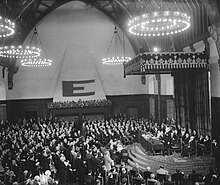
Back مؤتمر لاهاي (1948) Arabic Congrés de la Haia de 1948 Catalan Haager Europa-Kongress German Congreso de La Haya de 1948 Spanish Haagi kongress Estonian Claire Saunier French Congresso dell'Aia (1948) Italian Congres van Europa in Den Haag Dutch Haag-kongressen NB Kongres haski Polish

The Hague Congress or the Congress of Europe[1] was a conference that was held in The Hague from 7–11 May 1948 with 750 delegates participating from around Europe as well as observers from Canada and the United States of America.
The Congress, organized by Duncan Sandys and Józef Retinger, brought together representatives from across a broad political spectrum, providing them with the opportunity to discuss ideas about the development of European political co-operation. It was held under the auspices of the International Committee of the Movements for European Unity, subsequently to become the European Movement after the Congress.[2][3][4]
Important political figures, such as Konrad Adenauer, Winston Churchill, Harold Macmillan, Sir David Maxwell-Fyfe, Pierre-Henri Teitgen, François Mitterrand (both ministers in Robert Schuman's government), three former French prime ministers, Paul Reynaud, Édouard Daladier, Paul Ramadier, Paul van Zeeland, Albert Coppé and Altiero Spinelli, took part.
A broad range of philosophers, journalists, church leaders, lawyers, professors, entrepreneurs and historians also took an active role in the congress. A call was launched for a political, economic and monetary Union of Europe. This landmark conference was to have a profound influence on the shape of the European Movement, which was created soon afterwards.
The Spanish statesman Salvador de Madariaga proposed the establishment of a College of Europe at the Congress. This would be a college where university graduates from many different countries, some only a short while before at war with each other, could study and live together.
The Congress also discussed the future structure and role of the Council of Europe. Teitgen and Maxwell-Fyfe were instrumental in creating the Convention for the Protection of Human Rights and Fundamental Freedoms at the Council of Europe.
The Congress provided the means to heighten public opinion for European unity. On 20 July 1948, at the Hague meeting of ministers of Western European Union, Schuman's Foreign Minister Georges Bidault proposed the creation of a European Assembly (realized in the later Council of Europe) and a customs and economic union (the later European Coal and Steel Community and the two communities of the Treaties of Rome). Thus the conclusions of the Congress became French government policy and then the subject of European governmental policy.
- ^ Borchardt, Klaus-Dieter (2010). The ABC of European Union Law. Publications Office. doi:10.2830/13717. ISBN 978-92-78-40525-0.
- ^ Retinger, J. H. (1972). Joseph Retinger--memoirs of an eminence grise;. John Pomian. [Brighton]: Sussex University Press. ISBN 0-85621-002-1. OCLC 495575.
- ^ Mayne, Richard (1990). Federal Union : the pioneers : a history of Federal Union. John Pinder, John C. de V. Roberts. Houndmills, Basingstoke, Hampshire: Macmillan. ISBN 0-333-41995-2. OCLC 26163180.
- ^ Lane, Thomas; Wolanski, Marian (2009). Poland and European Integration: The Ideas and Movements of Polish Exiles in the West, 1939–91. Springer. pp. 81–86. ISBN 978-0-2302-71784.
© MMXXIII Rich X Search. We shall prevail. All rights reserved. Rich X Search